|
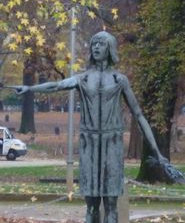 Dwight Peck's personal website Dwight Peck's personal website
Two weeks in Piemonte and Tuscany
in northwest Italy's worst weather in yonks
You may not find this terribly rewarding unless you're included here, so this is a good time for casual and random browsers to turn back before they get too caught up in the sweep and majesty of the proceedings and can't let go.
We wanted to visit Lucca and environs, and we did; now we're on our way home.
A sojourn in Sillavengo, a visit to Vercelli
First, Sillavengo

Along the Tuscan and Ligurian coast, and northward from Genoa past Alessandria and Casale Monferrato, we've fetched up way out in the Piedmont countryside, not too far north of Vicolungo (huh?) from the Biandrate autostrada exit, in Sillavengo (pop. 591) some 15km northwest of Novara. And this is why -- the Hotel Tenimento Al Castello.

Kristin thought that this place looked just right, and she was right, too. It's not really a castle, of course. It's a venerable villa or manor house in the middle of the farming community, originally owned by the Caccia family descended from Francesco Caccia, who was created "Lord of Sillavango" by Gian Galeazzo Sforza, the Duke of Milan, in 1483.

Apparently the villa acquired its name "the castle" because that's what the locals persisted in calling it in the old days.

The façade with the fake crenellations dates from the 19th century, but various other parts of the property are much, much older, and many of them are now available as hotel rooms, a very good restaurant, and facilities for parties and ceremonials of all kinds (and about half of them have still to be renovated, an ongoing process apparently).

The open courtyard and garden
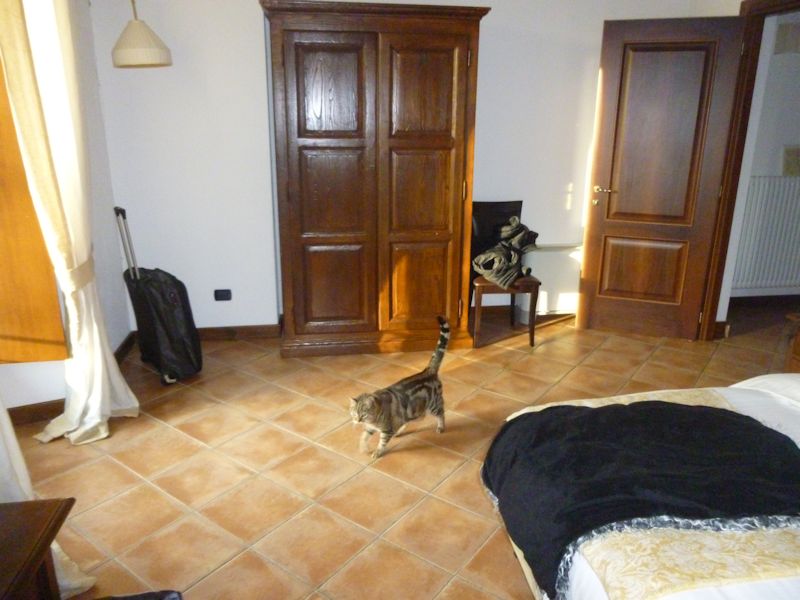
The Squirrel settling in

The closed garden from our room. The present main house and grounds evidently date from the 18th century but were built over and incorporated 16th and 17th century structures; the place has now got all the mod cons, however, though it still seems to be family-run with a small, very friendly staff. The dinner waitress was delightful.

The Squirrel working on her suntan on the balcony

The Caccia family sold up in the 1860s and moved to the Milan area, but the corridors of the hotel are virtually a shrine and museum to Dr Paolo Caccia Dominioni, 14th lord of Sillavengo, who seems to have had a distinguished career, especially on the North African front in World War Two, and whose drawings and maps of El Alamein, amongst others, and photos and newspaper clippings probably make a valuable resource for people who follow such things.

Beautiful downtown Sillavengo (that's not the only street; there's another)

The Chiesa Parrocchiale di Santa Maria delle Grazie (said to date from the 16th century, now in its 19th century incarnation)

The organ dates from the mid 17th century.

-- Good grief, you've got to get a look at this!

What would an Italian church be without . . .

The altar

Another church, the Chiesa di San Giovanni, said to date from the 13th century with improvements in the early 17th century, now left, it seems, to its own devices.

Corn in the streets. An ancient passing local gentleman explained that the town authorities just dumped it in the street for whomever wished to come and take what they wanted, and flew into a semi-rage about the irresponsible prodigality of that.

Back to the hotel (the less renovated side of it)
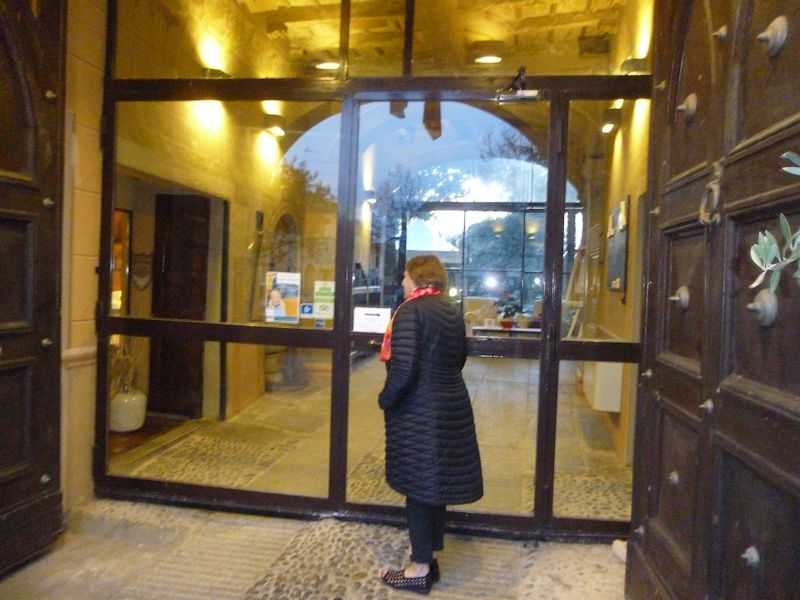
-- When you want to come in, just buzz. -- Buzz. BUZZ!

The salon in the reception area

The breakfast room (with an ample, varied breakfast)

The breakfast room

There's also an attractive restaurant (not shown here) that's well known for its traditional Piedmont dishes. I'm told that it passed all of Kristin's demanding criteria.

The "ice cave" -- apparently it really was a cold storage unit back in the day. And Kristin.

An archway into a closed courtyard within

The garden of the Castello hotel

-- Hey, Squirrel. Look out the window! (She's ignoring us again.)

Another of the many separate venues for festive occasions

The restaurant rooms are within. Tomorrow, we're off for some sightseeing in Vercelli, not too far off from here.
Next, Vercelli
Vercelli in the Piedmont region, founded in about 600 BC, is a city of ca.50,000 on the River Sesia, which descends from Monte Rosa and joins the Po at Casale Monferrato. Like most of the area roundabout, it excels in the cultivation of rice, with rice paddies all along our drive down from Sillavengo.
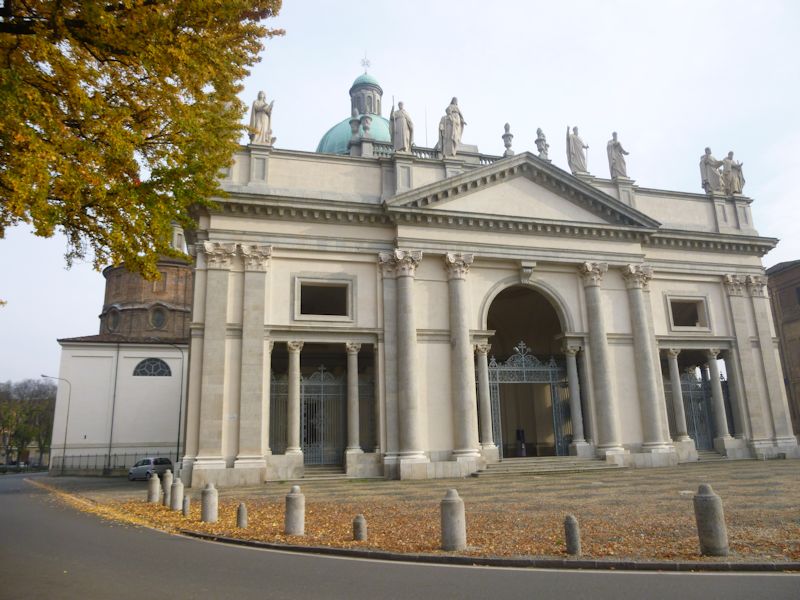
The Roman consul Marius defeated the invading Cimbri here in 101 BC. The city suffered from the same Guelph/Ghibelline fratricidal conflicts, and Visconti Milanese expansionism, throughout northern Italy in the 13th to 15th centuries, when in 1427 it fell under the sovereignty of the Savoie. It was captured by the French in 1499 and 1553, by the Spanish in 1616-17 and 1678, and by the French again in 1704. Seldom a dull moment.

This is the Vercelli Cathedral of St Eusebio, named for the city's first bishop (340s) who was a major player in trying to reconcile the Nicean orthodox and Arian factions in church politics of the 350s and '60s. He was responsible for the first cathedral on this site, but when it was destroyed during the Goth invasions of the 5th century, a replacement was put up and served admirably for centuries, until in the 16th century that one was knocked down and replaced by this big thing.
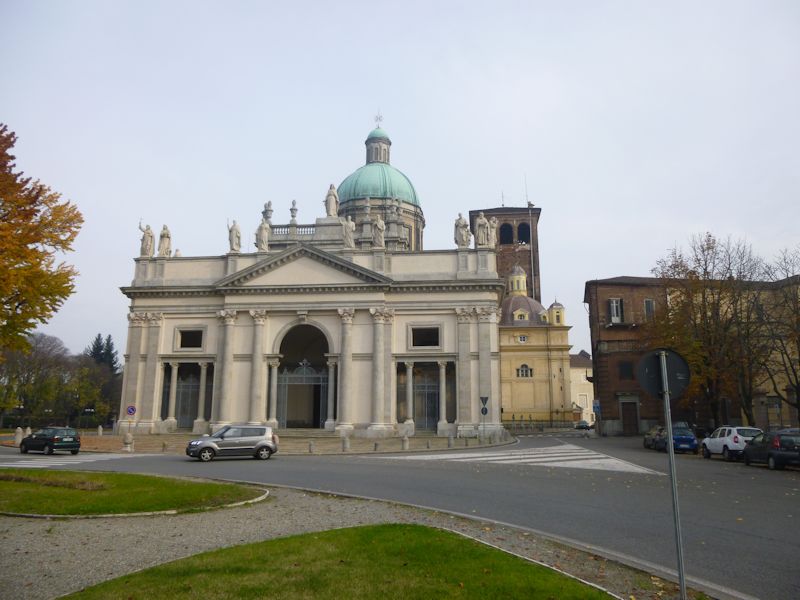
This big thing, which as it happens is closed today (all personal spiritual crises should wait until tomorrow), and in any case the front was completed in the 1760s, and the dome dates from 1860. So we'll just have to live with our disappointment.

The Cathedral campanile was built in the 12th century, anyway.

Turning south now, that looks a lot more interesting. The Basilica di Sant'Andrea, or St Andrew's church, was finished in 1227 and, as a monastic church, combines Cistercian traditions of both Romanesque and Gothic architecture.

Cardinal Bicchieri, formerly the papal legate to the English, ordered this built, drawing upon funds provided to him by King Henry III of England to built the abbey, church, and a hospital for travellers along the Via Francigena pilgrimage route to Rome. Emperor Frederick II, "Stupor Mundi", kicked his contributions into the kitty as well.

Views of St Andrew's basilica


The separated belltower was added in the early 1400s.

Zoom

The interesting façade is made of different kinds of green stone combined with red brick towers, two arcades and a huge rose window dominating the front. The three doors are framed by four sets of double columns each.

The Gothic interior is on a Latin cross plan with a nave and two side aisles, in the same combination of green stone and red brickwork. (A fabulous 800-year-old church to pray in, and they give them lawn chairs to sit on?)

The vaulted ceiling of the nave

Kristin in the nave, amongst the folding chairs, like for a hastily-called political meeting


Fancy inlaid woodwork in the choir, from the early 16th century
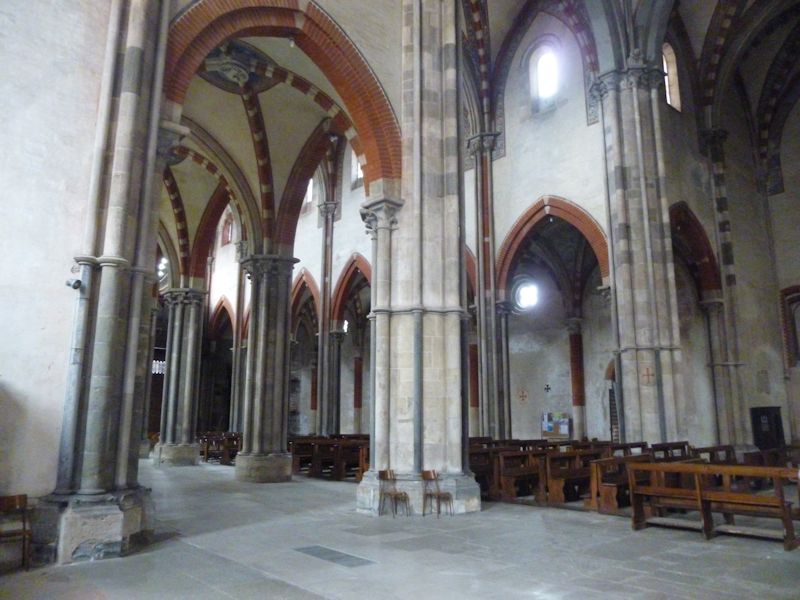
From the transept

An octagonal lantern tower and belfry at the crossing of the nave and transept

Straight up

The lovely cloister

We are left forever to regret that the sky wasn't blue. Or to come back someday and get it right.

In the 16th century the cloister was rebuilt, but the earlier small sets of four columns each were retained.


The Vercelli rail station -- we're actually here today to buy our train tickets for Turin tomorrow. And to investigate the cat food situation.

The Via Garibaldi, which runs south from the rail station half a kilometre to the central Piazza Nedo. We seem to be sightseeing, but actually we're looking for a special kind of cat food for very old cats.

A prominent statue. Contrary to expectations, that's not King Umberto I "the Good". Evidently that's Pietro Paietta Nedo -- astonishing resemblance.

Now, time running out, we're loping all over the city looking for special cat food for the Squirrel, pretty desperately. Everybody sends us in a different direction.

Bingo!

The Agri Zoo 2 has got it all.

The view of Vercelli from the Agri Zoo 2

The Q8 service station: "Open", "Self Service".

In Kennedy Park, this brilliant piece, which in summer would have been standing in a few inches of water -- after a bit of research, it turns out that it's by the sculptor Agenore Fabbri (1911-1998), called 'Mondina'.
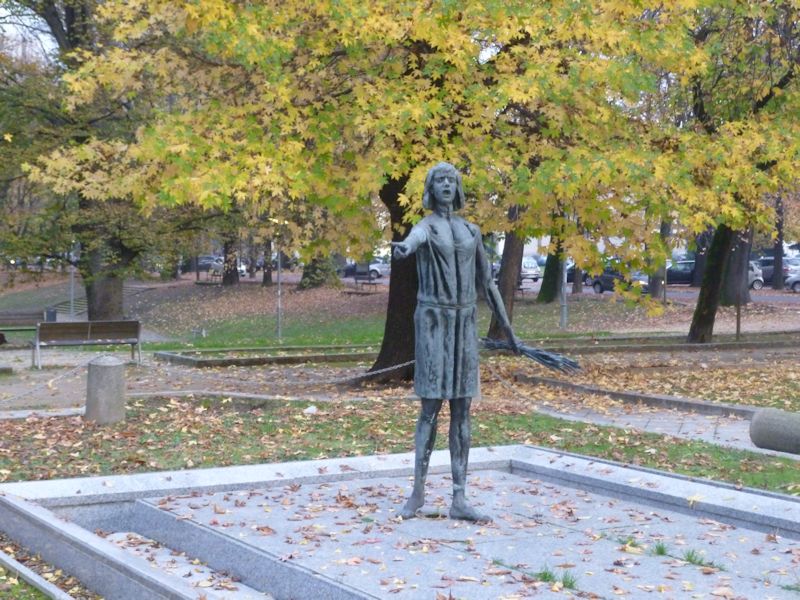
The mondine were the seasonal workers of the late 19th century who in the Vercelli and Novara provinces had the back-breaking job of weeding the rice paddies during the flooding season. The hours were impossible, and the pay was ridiculous for men, worse for women. Civil unrest and riots between 1906 and '09 resulted in regulations to improve their lot, though the later use of herbicides rendered that moot.
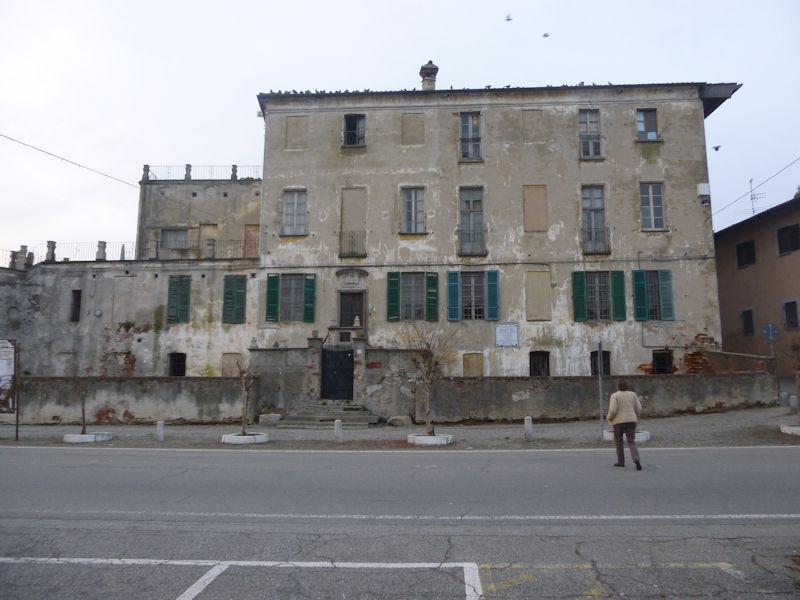
A very sad scene. This wreck, in the suburban village of Borgo Vercelli, commemorates by a plaque the presence here of the immortal poet Torquato Tasso, who as a young man wrote the great romantic epic La Gerusalemme liberata (1574), fancifully centered on the First Crusade, and became the giant of the Italian literary scene, but went quietly paranoid and madly querulous over the 1570s at the court of Ferrara, and restive amongst the well-meaning restraints of Duke Alfonso II d'Este and other patrons. In 1578, he escaped and roamed from city to city ("triste pellegrinaggio"), basking in the accolades of his hosts and wearing out his welcome very fast in each one, until the Ferrarese took him back, but then felt obliged to stick him in the madhouse of St Anna for his own good.


Not much left of that one.
       
     

 Feedback
and suggestions are welcome if positive, resented if negative, Feedback
and suggestions are welcome if positive, resented if negative,  .
All rights reserved, all wrongs avenged. Posted 16 January 2015. .
All rights reserved, all wrongs avenged. Posted 16 January 2015.
|
 Dwight Peck's personal website
Dwight Peck's personal website













































































